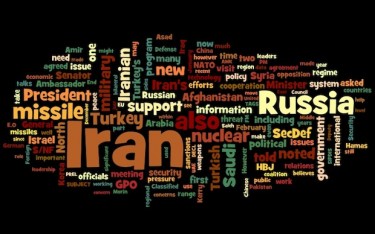Cablegate is everywhere. You can read about it in virtually any digital or print newspaper around the world; you can see it through the links shared on social media sites; you can follow the tag #cablegate [1] on Twitter; you can browse dozens of blogs; you can hear about it on the radio. Wikileaks’ release of over 250,000 United States embassy cables is one of the hottest subjects in media and government right now: technology reduced the gap between citizens and complex government information, and people are actively discussing the release [2] throughout the world.
As Geert Lovink and Patrice Riemens point out in their article “Ten Theses about Wikileaks [3],” the organization's release of sensitive government information used technology to capture the attention of millions:
Wikileaks manages to capture that attention by way of spectacular information hacks where other parties, especially civil society groups and human rights organizations, are desperately struggling to get their message across. Wikileaks genially puts to use the ‘escape velocity’ of IT — using IT to leave IT behind and irrupt into the realm of real-world politics.
But which tools are they using to capture and keep the attention of people and media, and ultimately change the government opaqueness they fight? More importantly, how can citizens collaborate in this innovative, real-time, diplomacy-focused call for accountability?
Traditional media partners
Wikileaks gave five major media outlets — the The Guardian [4], Le Monde [5] [fr], El País [6], Der Spiegel [7], and New York Times [8] — preliminary access to the cables. By combining a digital release with publication by traditional media, Wikileaks — and other online transparency organizations — are able to reach a broader audience and spread information in different formats and vehicles. Wikileaks’ constant updates on Twitter even made it to the U.S. Department of State press conference and several international media organizations who made references to them.
Visualization tools
The majority of Wikileaks’ media partners and the Cablegate site [9] are using easy-to-understand graphics to communicate the data in a more comprehensive way. Information Aesthetics has a roundup of the different visualization techniques [10]. Fast Company has taken a slightly different approach, constructing a Wordle based on the cables. [11]

Cablegate Wordle, via Fast Company [11]
Crowdsourcing
Cablegate created a way where any user anywhere around the world can easily browse and locate any cable of interest for them and draw their own conclusions. Wikileaks is inviting users to search for events that happened in their own countries. They can, for example, check key dates of relevant events to see if they can find any references in any cable, then share their analyses and findings using Web 2.0 tools. This is essentially crowdsourced accountability by anyone, anywhere in the world. Other organizations are taking advantage of this, encouraging citizens to “get their hands dirty” and dig through the cables for relevant information: the National Security Archive blog “Unredacted” published [12] a guide on how to read Department of State documents and a list of commonly used acronyms in the cables.
Wikileaks is encouraging [13] citizens to share their findings:
Pick out interesting events and tell others about them. Use twitter, reddit, mail whatever suits your audience best. For twitter or other social networking services please use the #cablegate or unique reference ID (e.g. #66BUENOSAIRES2481) as hash tags.
Perhaps we are witnessing a change of era, where the voices of citizens will replace the whispering of secrets behind close doors and foreign relations will switch to a more open diplomacy. Perhaps not. Regardless, after this release the world will have a new model to follow.